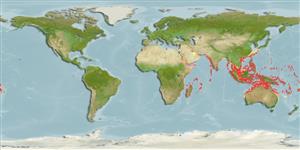Teleostei (teleosts) >
Perciformes/Serranoidei (Groupers) >
Anthiadidae (Fairy basslets or Streamer basses)
Etymology: Pseudanthias: Greek, pseudes = false + Greek, anthias = a fish, Sparus aurata (Ref. 45335).
More on author: Smith.
Environment: milieu / climate zone / depth range / distribution range
Ecology
Marine; reef-associated; depth range 20 - 100 m (Ref. 90102), usually 40 - 54 m (Ref. 9710). Tropical; 22°C - 29°C (Ref. 130612)
Indo-West Pacific: East Africa, Maldives and Indonesia.
Size / Weight / Age
Maturity: Lm ? range ? - ? cm
Max length : 14.0 cm TL male/unsexed; (Ref. 8631)
Dorsal spines (total): 10; Dorsal soft rays (total): 16; Anal spines: 3; Anal soft rays: 7 - 8. Displays different or stronger color patterns when living together with similar looking species to enhance recognition by females which may lead to further speciation (Ref. 48635).
Inhabits deep coastal drop-offs (Ref. 8631, 48635). In Java Sea, taken only in dead reef areas in somewhat turbid water (Ref. 8926). Closely related species such as P. pleurotaenia and P. bimaculatus may spawn at the same time and produce accidental hybrids (Ref. 48635).
Life cycle and mating behavior
Maturity | Reproduction | Spawning | Eggs | Fecundity | Larvae
Randall, J.E. and M. Hutomo, 1988. Redescription of the Indo-Pacific serranid fish Pseudanthias bimaculatus (Smith). Copeia 1988(3):669-673. (Ref. 8926)
IUCN Red List Status (Ref. 130435: Version 2024-1)
Threat to humans
Harmless
Human uses
Fisheries: of no interest; aquarium: commercial
Tools
Special reports
Download XML
Internet sources
Estimates based on models
Preferred temperature (Ref.
123201): 25.6 - 28.4, mean 27.4 °C (based on 264 cells).
Phylogenetic diversity index (Ref.
82804): PD
50 = 0.5000 [Uniqueness, from 0.5 = low to 2.0 = high].
Bayesian length-weight: a=0.01349 (0.00618 - 0.02945), b=3.00 (2.81 - 3.19), in cm total length, based on LWR estimates for this (Sub)family-body shape (Ref.
93245).
Trophic level (Ref.
69278): 3.4 ±0.4 se; based on size and trophs of closest relatives
Resilience (Ref.
120179): High, minimum population doubling time less than 15 months (Preliminary K or Fecundity.).
Fishing Vulnerability (Ref.
59153): Low vulnerability (10 of 100).
